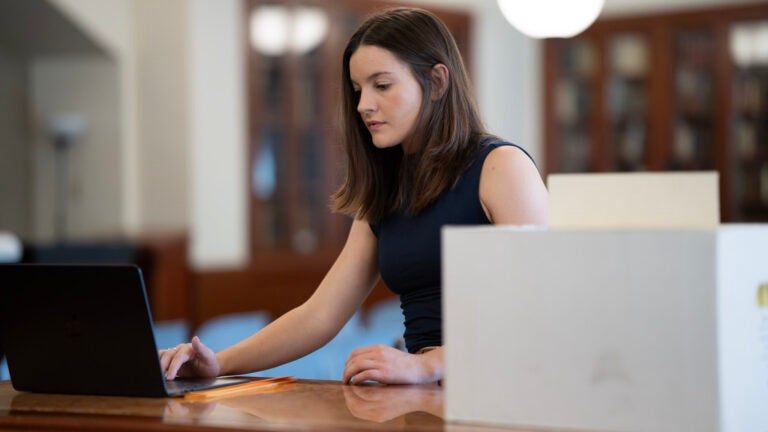
2024 Wrigley Institute Graduate Fellow Amber Santoro conducts primary source research focused on the social and environmental impacts of freeway construction in Los Angeles (Nick Neumann/USC Wrigley Institute)
Anti-Freeway Fervor in California: Can History Point Us in a More Equitable Direction?
Living in Los Angeles, we rely heavily on freeways for our transportation needs. In many areas, public transit options are limited, making freeways a crucial part of daily life. But have you ever wondered about the history of these freeways that dominate our landscape? How did they come to be, and what was there before? Each freeway route has its own story, often involving protests and community displacement.
My PhD research at USC focuses on the history of environmental racism and its relevance to transportation and sustainability. Growing up in Los Angeles, I became curious about the social and historical impacts of freeways. My interest in this topic was sparked by stories from my grandmother about her childhood home in East Los Angeles. In the 1960s, my great-grandparents were displaced from this home to make way for the 710 freeway. My fellowship through the Wrigley Institute has connected me to a diverse community of scholars, which has been instrumental to my understanding of the intersection of communities like my grandmother’s and sustainability.
The first freeways in Los Angeles, the Arroyo Seco Parkway (I-110) and the Cahuenga Pass Freeway (I-101), opened in 1940. Before these, Los Angeles had the “Red Car” public transit system, which was the main mode of transportation for many Angelenos until its formal disbandment in 1950. The postwar era saw a boom in freeway construction, put into motion by the Collier-Burns Highway Act of 1947, which funded these projects through a statewide fuel tax.
While plans for a Beverly Hills Freeway, connecting the I-10 with the I-101, were initially on the table, vehement opposition effectively ended that proposal. Despite the grand aspirations of early freeway project stakeholders in California, by the early 1960s, opposition to freeway construction, undergirded by concurrent environmental movements, was steadily gaining momentum.
While the construction of the Century Freeway (today’s I-105) was not completed until 1993, its origins can be traced back to the Federal Highway Act of 1956. Enacted by President Dwight D. Eisenhower, this legislation paved the way for a 40,000-mile national system of interstate and defense highways to be constructed over a span of 13 years. State politicians and urban planners harbored lofty and idealistic visions for Route 42, as today’s Century Freeway was then known. Plans were first set in motion in 1958, envisioning a 10-lane thoroughfare stretching 51 miles from Los Angeles to San Bernardino. By the mid-1960s, a principal route for Route 42 had been laid out by the Division of Highways, starting around Martin Luther King Jr. Boulevard and running parallel to Century Boulevard, hence earning its name, the Century Freeway.
However, by this time, freeway revolts had begun surfacing in San Francisco. Dissatisfaction among San Franciscans stemmed from the California Division of Highways’ proposals to extend freeways across the region. A pivotal moment occurred in 1964 when a rally in Golden Gate Park protested the proposed Panhandle-Golden Gate Freeway plan. Subsequently, the San Francisco Board of Supervisors rejected $250 million in federal financing for two interstates proposed to go through the city. This 6:5 decision from the board has been said to be the final nail in the coffin for San Francisco’s freeway program. However, south of San Francisco in the bustling city of Los Angeles, the government approved the reallocation of the rejected $250 million to the Century Freeway project, transforming the project from a state route into an interstate.

While freeways are often associated with noise, pollution, and environmental degradation, scholars have highlighted that their social and economic impacts can be even more immediate and severe for individuals directly in the highways’ paths, often leading to the fragmentation of communities. The Century Freeway, which I have highlighted in my research during my time at USC, serves as a stark example of this phenomenon, as thousands of people were forcibly displaced from their homes over the 30 years of development.
Today, many inquiries into managing freeway congestion, and questions regarding the future of mobility and transit in Los Angeles, are being posed. Most pressingly, concerns are raised over the implementation and expansion of Metro ExpressLanes, which, for a fee, let freeway-goers bypass the bulk of traffic congestion. Is this the way forward? Looking closely at the history of freeway constructions and the countless people impacted may point us to answers. Highlighting the voices of those impacted by such developments can help us navigate solutions in a way that centers community and compassion, as the trajectory of the Century Freeway informs us.
There is a growing emphasis on creating more walkable cities, adopting electric vehicles, and exploring public transportation alternatives. These discussions are closely tied to questions about how historical urban infrastructure has impacted marginalized communities—an issue that Los Angeles is grappling with, especially as infrastructural concerns related to the upcoming 2028 Los Angeles Olympics come sharply into focus.
Over the summer, funding from the Wrigley Institute has helped me begin navigating regional archives and building a new understanding of transportation and community activism. Working with lesser-known historical archives and centering the voices of the affected individuals at the forefront of such debates is a step forward in creating a more equitable and inclusive transportation future for Los Angeles.
Amber Santoro is supported by the Diane Sonosky Montgomery and Jerol Sonosky Graduate Fellowship for Environmental Sustainability Research.